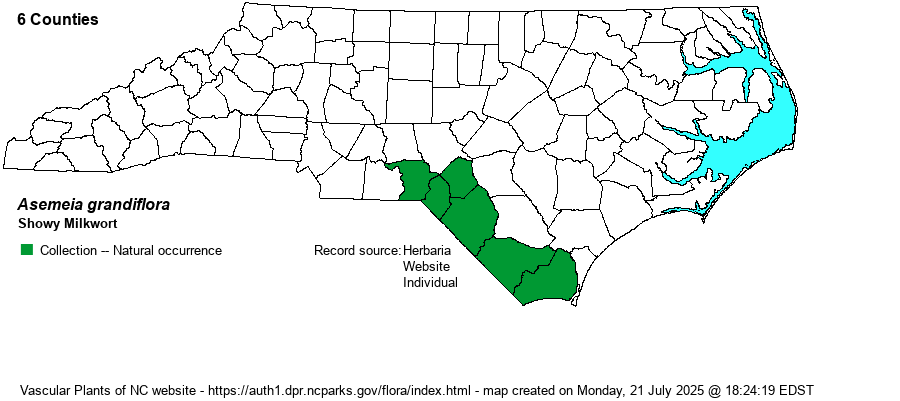| Author | (Walter) Small | |
| Distribution | Essentially in the southern half of the Sandhills region, but present eastward into the middle Coastal Plain in Robeson County, and disjunctly to southern Columbus County and a recent specimen from Brunswick County (NCU). Not yet known from northern Sandhills counties -- Moore, Harnett, and Cumberland.
This is a Southern species, found in most counties in its range from southern NC to southern FL and west to eastern LA.
| |
| Abundance | Rare to uncommon in its six-county range in NC. This is a Significantly Rare species. | |
| Habitat | This is a species of sandy soil, found not just in pine/scrub oak sandhill communities but also in clearings, roadsides, and other sandy openings -- away from natural habitats. Several of the populations from the Sandhills Game Land in Richmond and Scotland counties occur in loamy sand of slight depressions or head-ends of former streamheads. | |
| Phenology | Blooms from May to July, and fruits soon after flowering. | |
| Identification | This is a slender herb with a branch or two, from the base or upper portions, growing erect to about 12-15 inches tall. It has scattered, alternate leaves that are elliptical to oblanceolate, entire, to 1.5 inches long and 1/3 as wide. The top 3-4 inches of each branch is a terminal raceme of rosy-pink flowers, scattered along the axis; the spread of the two side wings is about 3/5-inch across. Thus, even though each flower is somewhat small, they are larger than most of the other "Polygala" species, as this species was until recently placed in that genus with many other NC species. In essence, it looks like a small pink-flowered smartweed but in sandy soil. | |
| Taxonomic Comments | Until recently, this was included in the large genus Polygala, as P. grandiflora.
| |
| Other Common Name(s) | None | |
| State Rank | S2 | |
| Global Rank | G5? | |
| State Status | SR-P | |
| US Status | | |
| USACE-agcp | | |
| USACE-emp | | |

